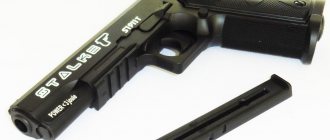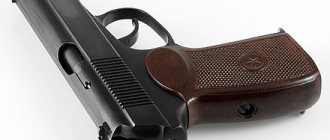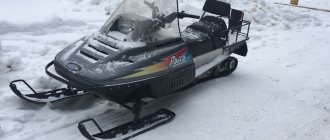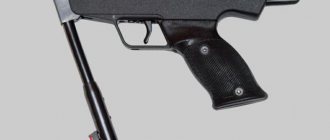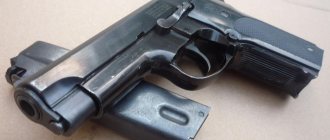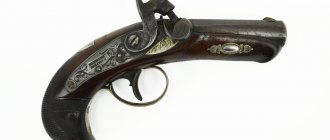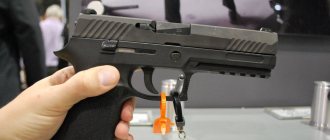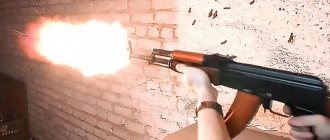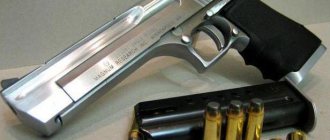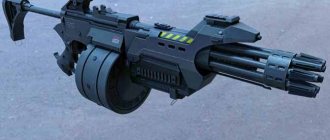Colt revolvers (USA)
The history of the world famous, founded in the mid-19th century. one of the most talented entrepreneurs of his time, Samuel Colt, knows the ups and downs, tremendous commercial successes and no less significant failures. The company was reorganized several times, changing owners and names, but the quality of weapons with the Colt brand, its prestige and reliability remained unchanged. The commitment to producing revolvers for various purposes, from civilian to military, remains just as unshakable. The reason for this commitment becomes clear if we trace history.
The first enterprise of Samuel Colt, who came from a wealthy aristocratic family, went bankrupt in the 1840s, and only the success of some models of the then capsule revolvers adopted by the cavalry units of the US Army allowed the enterprise to survive at the time of crisis. In 1847, Colt founded a company called Colt's Patent Firearms Manufacturing, which produced exclusively revolvers. The American Civil War brought great success to the products of Samuel Colt's enterprise, but the founder himself did not live to see the best days of his company, dying in 1862 at the age of 47.
Revolver "Colt Police Positive Special"
Under the leadership of talented managers, it has not lost its position in the arms market. In a tough struggle in the revolver market with its competitors, the main of which was S. Colt’s enterprise, it was possible to improve its products so much as to remain among the main weapon manufacturers.
At different times, the developers of revolver weapons produced many types of revolvers, which were improved from model to model. The main trend was a gradual shift from army weapons to police and civilian ones. And if the army’s refusal of revolvers in favor of automatic pistols is easy to understand, then the US police’s commitment to revolvers is difficult to explain. It is believed that revolvers have one advantage over pistols - fewer failures due to misfires, jamming of cartridges, etc. But with the advent of new pistol designs after World War II, this advantage was practically eliminated, so that in the future a gradual transition of the US police to pistols is expected. Nevertheless, even in the American army, if you believe the statistics, back in 1982, 418,000 Colt M 1911 A1 self-loading pistols and 136,000 revolvers of various makes and years of manufacture were used.
One of the most popular models of police revolvers is the “Colt Police Positive Special”. Appearing in 1908, it absorbed the advantages of all previous police developments, which had previously had considerable success and a reputation as a reliable police weapon. One of the first police revolvers was the New Police model, developed in 1896 and chambered in .32 caliber. The simple and reliable weapon was produced in a large batch of 50,000 units for that time, sold by police forces in the United States and Canada.
In 1907, the “Police Positive” model appeared, also designed for the .32 caliber cartridge to replace the previous model. This revolver was expected to be an even greater success in the arms market. According to some reports, before 1939, about 200,000 Colt Police Positive revolvers were produced. Having created in 1905 the “Police Positive” modification for a more powerful .38 caliber ammunition, it significantly strengthened its position as a manufacturer of police revolvers. The .38 Colt Police Positive proved to be a powerful and reliable weapon that was a great success. Until 1943, when production of this model was discontinued, more than 200,000 weapons of this modification were produced. A significant part of this batch was purchased by European states. In 1928, the “Bankers Special” model appeared, which is a shortened version of the “Police Positive” model in .38 caliber and was intended to strengthen its position in the market for civilian self-defense weapons.
Based on the ideas tested on previous models, one of the most popular police revolvers was released - the “Police Positive Special” model. There were modifications chambered for .32 Winchester, .38 Smith & Wesson, and .38 Special. Accordingly, the length of the revolver barrel was different.
Read: Consolidated B-24J Liberator - the most popular bomber in aviation history
Having tried to take into account all the predilections of police officers for the ammunition used and the dimensions of the weapon, the manufacturing company achieved attention from the police departments of many countries, primarily the United States. From 1908, when this revolver appeared, until the 1970s. Over 700,000 units of the Colt Police Positive Special were produced. Subsequently, another modification of it was produced - the “Detective Special” model, developed in 1927. In some ways, this model copied the idea of the “Bankers Special”. Having reduced the dimensions of the “Police Positive Special” revolver, the creators tried to embody the dream of police officers in the “Detective Special” model: a small-sized revolver, most suitable for concealed carry, chambered for a powerful cartridge.
By the beginning of the 1980s. About half a million of these revolvers were produced. In total, according to some information, the number of produced “Police Positive Special” models together with “Detective Special” has so far amounted to about one and a half million.
Revolver "Colt Trooper" Mk. III
Unlike the Colt Police Positive Special model, modifications of which were constantly decreasing in size and weight, Colt Trooper brand revolvers were initially conceived as large-caliber powerful weapons, suitable for self-defense and equipping police officers, as well as for fans of sports shooting and hunting. . The appearance of the first models was identical to another development - the “Army Special” model revolvers, which was later replaced by the “Official Police” model from the beginning of the 20th century. Reliable and simple, these models have long remained the standard weapon of the US police. Suffice it to say that until 1969, about half a million units of the Official Police model revolver were produced.
The Colt Trooper revolver was developed in 1953 as a new weapon design that was not an improvement on any other model. The engineers equipped their development with an adjustable sight and a large front sight with a beveled base, as well as a barrel with a rail and a pencil case for the extractor, which somewhat complicated the design, but was convenient for both sport shooting and police use. The Trooper model had a number of modifications, differing in barrel length and caliber, designed to meet different user requirements for a revolver.
There were modifications of this weapon chambered for .22, .357 (“Magnum”) and .38 (“Special”) calibers. For some time, the Trooper modification chambered for the .357 Magnum cartridge was considered a separate model due to its improved design, in particular the enlarged grip cheeks. But in 1961, after the production of about 15,000 units, this modification was no longer distinguished as an independent model.
Speaking about the originality of the “Trooper” model, we cannot remain silent about the fact that creating a completely original revolver is an almost impossible task, the design of the revolver itself is so simple. We should also not forget about the great variety of modifications of revolvers created by the world's leading manufacturers. In the case of the Trooper, there is a clear design similarity with the already mentioned Colt Police Positive Special model.
The fate of both revolvers is similar. By 1970, their production was discontinued due to the stated intention to update the range of revolvers. For the same reason, the above-mentioned “Official Police” model ceased to exist. Since 1969, their place has been taken by the Mk series revolvers. III. By this year, such a situation had developed that its closest competitors, in particular Ruger, began to actively squeeze out the market.
This is partly due to the concentration of large forces in other segments of the arms market. There is also an opinion that the policy in the field of creating new modifications of revolvers remained too conservative for several decades, which led to some lag. The appearance of the Mk series. III was intended to restore parity. Structurally, the outdated designs of the lock and trigger of revolvers were redesigned. All main parts began to be strengthened by hardening. The versatility of some weapon components was achieved, which acquired the properties of interchangeability among different models. In addition to a noticeable reduction in the cost of production of Mk series revolvers. III, all this led to an increase in the reliability of the weapon.
Read: M1 Garand rifle
The Colt Trooper revolver acquired a second life under the designation Trooper Mk. III. Like the standard Trooper, the new model is chambered for .357 Magnum and .38 Special cartridges. In appearance, the revolver acquired the features of another revolver - the “Colt Cobra”, released simultaneously with it, due to the powerful under-barrel case in which the cartridge ejector was located.
In addition to the Trooper Mk. III, to the Mk series. III also included the following models:
- "Official Police" Mk. III chambered for .38 “Special” - an improved version of the “Colt Official Police”, had non-adjustable sights; — "Metropolitan" Mk. III chambered for .38 "Special" - variant of the "Official Police" Mk. III, adapted to the requirements of the metro police; — "Lawman" Mk. III chambered for .357 "Magnum" - an enlarged "Official Police" model with a heavier barrel chambered for more powerful cartridges, and was also equipped with a non-adjustable sight.
Variety, reliability and competitive price of Mk series revolvers. III made it possible to restore its shaky position as a manufacturer of weapons for the police and self-defense.
In 1982, a new series of Colt revolvers was introduced, designated Mk. V.
The design of this weapon is a further development of the Mk series revolvers of the same name. III and differs only in the modernized trigger and improved production technology. In particular, the mainspring was lengthened almost 2 times, and the cocking stroke was reduced. This made it possible to reduce the “response” time of the revolver to pressing the trigger (i.e., the firing time of the striker), which had a positive effect on shooting accuracy. Today, the US revolver market is dominated by the trio, Smith & Wesson and Ruger. By constantly improving the quality of their designs, none of them can achieve overwhelming dominance. But we should not forget that behind the Colt brand are no less significant types of weapons from other segments of the arms market, namely self-loading pistols and assault rifles. This fact, of course, adds prestige to Colt products, although it cannot be decisive in redistributing the market in favor of this company.
In the post-war world in the arms market, for successful business, not only the reputation of the arms manufacturer, but also the image of a particular type of weapon is becoming increasingly important. I was one of the first to understand this. Instead of naming their models with a faceless alphanumeric designation, as some of their competitors did, they were given new sonorous names, which were then promoted by the company's marketing department. This is how the famous “snake” series of revolvers appeared.
It all started in the mid-1950s. one of the modifications of the “Detective Special” revolver was called “Colt Cobra”. Nothing special was added to the design of the revolver. “Cobra,” designed for .38 “Special” and .357 “Magnum” cartridges, had only a lightweight alloy body, which significantly (almost halved) the weight of the weapon. Later, the revolver's drum was also replaced with a lighter version. The light weight of the weapon generated great interest from various US departments. In particular, there is a known order for a batch of Cobra revolvers, intended to arm aircraft crews, which is a rather rare case in post-war practice - the military still prefer pistols. And although the “Colt Cobra” never went on commercial sale, marketing specialists appreciated the potential of a successful designation for a revolver.
Here we need to dwell in more detail on the Magnum brand ammunition, which is not without reason considered to be monsters among pistol and revolver cartridges. Magnum cartridges were a cross between pistol and rifle cartridges in power. Having a bullet completely similar to a revolver in size and weight, the cartridge had an elongated cartridge case and an increased mass of the powder charge. Weapons developed for such a cartridge had to have a special design. Of course, the .357 Magnum cartridge gives the image of all revolvers and pistols produced under it a certain special quality.
Colt Python revolver
When in the mid-1950s. decided to deviate somewhat from its traditional principles of revolver layout, it was decided to give the new development a sonorous name. In 1953, Colt Python appeared. The main slogan under which the advertising campaign for this model was carried out was the motto: “Colt Python” is the best revolver in the world.” The revolver model had excellent accuracy for its class due to a special type of barrel rifling with an unusual pitch. In addition, the revolver was equipped with a rather complex aiming mechanism, adjustable for range and climatic conditions. It is also worth mentioning that the upper edge of the barrel, to eliminate the glare effect when aiming, was covered with notches in the form of round depressions.
Read: Kalashnikov assault rifle
But this was not the main factor that ensured the commercial success of the weapon. Just look at its appearance, and it becomes clear that this is a weapon for serious men. Made of stainless steel (there were options made of ordinary steel with nickel plating) and having impressive dimensions, the revolver made a very serious impression. The barrel of the pistol was reinforced at the top due to a special ventilated strip, and at the bottom with a pencil case in which the ejector rod for empty cartridges was placed. The powerful 357-caliber revolver did not require additional cooling. The reinforced barrel, firstly, reduced the jump effect when firing, and secondly, played an image role, as if saying: “Look how powerful I am.” In the future, the Python model was expected to be a great commercial success. In fact, at one time it was the only alternative to the excellent revolver model 14K38 produced by .
Revolver "Colt Anaconda"
Initially, Python revolvers were released in a version with a 6-inch barrel, later modifications appeared with barrels ranging from 2.5 inches in length, intended for concealed carry, to 8 inches (for hunting and target shooting). Revolvers were produced until approximately the mid-1960s. Currently, the mass production of weapons of this type has been discontinued, but they are manufactured to individual orders by the Colt Custom Shop workshops.
In 1986, the Colt King Cobra revolver appeared, which was an analogue of the Colt Trooper Mk. V chambered for the .357 Magnum cartridge and featured a “snake” design with a weighted, non-ventilated barrel and an under-barrel case for the entire length of the barrel. This weapon had all the design features of the Colt Mk series revolvers. V, was produced with barrels ranging from 2 to 6 inches in length and was equipped with adjustable sights. Production of King Cobra revolvers was discontinued in the late 1990s. With the advent of ammunition even more powerful than the .357 Magnum, the theme of “Big Barrel for Serious Men” continued, now reaching almost absurdity. Some recent models of revolvers have much greater bullet stopping power than Kalashnikov assault rifles. So, in 1990, the Colt Anaconda revolver appeared. With an unnatural weight for a revolver of 1.6 kg and a length of 35 cm, it exactly repeated the Python design. But the main feature of the revolver was the .44 Magnum cartridge, which has enormous destructive power and corresponding recoil when fired (some modifications were even produced with integrated recoil compensators in the form of holes in the muzzle of the barrel).
It is hardly possible to learn how to accurately shoot from this weapon even at short distances, and it is unlikely that anyone will use it as a service weapon. “Colt Anaconda”, like all weapons produced under similar cartridges, is, firstly, a hunting and sporting revolver, and secondly, a purely fashionable revolver, the possession of which automatically establishes a certain special status for the owner.
You might be interested:
- Revolver "Colt"
- Design of the Colt Trooper Mk revolver. III
- Colt Python revolver design
- Revolvers "Taurus" (Brazil)
- Colt pistols (USA)
- Revolvers "Smith & Wesson" (USA)
Subscribe to
our channel in Yandex.Zen
Description
Despite its popularity, it was a simple, but at the same time powerful and heavy revolver, a combination of the design of previous Colt capsule revolvers - the trigger mechanism, the design and construction of the handle and partly the trigger, with a more modern monolithic closed frame and the use of unitary cartridges central battle.
Reloading a Colt SAA revolver
This technical solution (successful in technological terms, but not very successful structurally) was apparently applied with the aim of using the same factory equipment and tooling for the production of weapons that was used for the production of capsule models of revolvers. On the bottom surface of the solid frame, which smoothly flows to the handle, there is a small, flat safety bracket. The shape of the weapon's handle expands downward, making it more ergonomic. It is set quite low on the frame, due to which the aiming line is higher than the hand holding the weapon.
The drum was, as a rule, not fully loaded, but with a maximum of five cartridges, that is, one chamber, opposite the barrel, had to remain empty in order to avoid an accidental shot[19]. Since it was a revolver with a solid frame, reloading was done through a door on the right side that folded to the side - and so on one cartridge at a time, but before that the trigger was placed half-cocked so that the door itself opened. The large trigger, in which the firing pin was attached with a pin, in the lowered position was almost completely hidden in the dome-shaped shield of the frame, with the exception of the knitting needle. The elongated shank, curved to fit the thumb, was covered with a deep notch. A semicircular front sight was soldered to the muzzle of the cylindrical barrel, which was attached to a thread in the frame. On the right side, under the barrel, an ejector case was attached, in which a spring ejector ramrod was mounted with a button shaped like a washer, which was soon reduced to a crescent shape.
Internal organization
| cylinder with ratchet - drum with ratchet | hammer with hand - trigger with a spoke (with a roller) | |
| base pin - drum axis | main spring - mainspring | |
| base pin bushing - movable tube | cylinder locking bolt - drum stopper | |
| ejector tube - ejector tube | trigger - trigger | |
| ejector with spring - ejector with a spring | trigger/bolt spring - trigger/stopper spring |
Notes
Comments
- The cause of the fire was never determined, but it was suspected that it was sabotage by the Confederacy at the height of the Civil War.
- Other companies could produce revolvers chambered for a unitary cartridge only if they paid royalties to S&W. But the cost of the license was quite high, so many companies produced revolvers illegally, violating patent law.
Sources
- Brett J. Cruse, 2008, p. 45.
- ↑ 12345678
Fedoseev S., Ardashev A., 2020, p. 12. - Hogg, Weeks, 1999, p. 77.
- ↑ 12
Hogg, Weeks, 1999, p. 77. - ↑ 12
Strickland Jeffrey, p. 32. - ↑ 123
Colt. History. - Arthur P. Molella, Anna Karvellas.
Places of Invention / Arthur P. Molella, Anna Karvellas, Karvellas. - Washington: Smithsonian Institution, 2020. - P. 312. - ISBN 978-1-935623-68-7. - Herbert G. Houze, Carolyn C. Cooper, Elizabeth Mankin Kornhauser.
Samuel Colt: Arms, Art, and Invention // Wadsworth Atheneum Museum of Art series / Elizabeth Mankin Kornhauser. - Yale University Press, 2006. - P. 260. - ISBN 978-0-300-11133-0. - Coltsville.
- Hogg V. Ian, 1978, p. 40.
- ↑ 12
Hogg V. Ian, 1978, p. 120. - T Holloway.
A Guide to Handgun Cartridges. - Lulu.com, 2020. - P. 222. - ISBN 978-1-329-00762-8. - Hogg V. Ian, 1978, p. 306-307.
- Hogg V. Ian, 1978, p. 283.
- Hogg, Weeks, 1999, p. 74.
- Sytin L., 2012, p. 464-465.
- Strickland Jeffrey, p. 50-51.
- Editorial staff of FHM (For Him Magazine).
FHM (For Him Magazine) 01-2014. - Litres, 2014. - P. 71. - ISBN 978-5-4577-0426-8. - Strickland Jeffrey, p. 51.
Literature[ | ]
In Russian
- Ian Hogg, John Weeks.
All pistols in the world / Complete illustrated reference book of pistols and revolvers. - M.: Eksmo-Press, 1999. - ISBN 5-04-000401-X. - Semyon Fedoseev, Alexey Ardashev.
100 best “guns”: pistols, machine guns, rifles, machine guns. - M.: Litres, 2020. - ISBN 978-5-9955-0864-9. - L. Sytin.
All about firearms. - M.: Litres, 2012. - ISBN 978-5-271-43478-5.
In English
- Jeffrey Strickland.
Handbook of Handguns. - Colorado Springs, CO: Lulu.com. — ISBN 978-1-3009-7329-4. - Ian V. Hogg.
The Complete Illustrated Encyclopedia of the World's Firearms. - New York: A & W Publishers, Inc., 1978. - P. 320. - ISBN 0-89479-031-5. - J. Brett Cruse.
5. Army and Indian Strategies, Tactics and Weapons // Battles of the Red River War: Archeological Perspectives on the Indian Campaign of 1874. - 2008. - P. 249. - ISBN 978-1-60344-027-1. - David Chicoine.
Guns of the New West: A Close Up Look at Modern Replica Firearms. - Krause Publications, 2005. - 264 p. Archived copy from April 14, 2020 on the Wayback Machine
THE WORN SADDLE CREAKS AGAIN
If knocking noises appear in the front suspension by 60–70 thousand km, then most likely the stabilizer bushings have worn out. The struts are sometimes silent even with a mileage of 150 thousand km, since they are made simply and reliably: two studs with four rubber buffers for each (as on the “Muscovites” of the 408–2140 families). Such designs, devoid of ball pins, are very durable, and when you still have to change them, be very careful about buying new ones. You can run into ordinary bolts with bushings from toilet bowls. These bushings will fall apart very quickly! Ball joints and steering fingers are unlikely to rattle even by 150 thousand km.
If creaks appear in the front, options are possible. When the suspension moves up and down, the corrugations-anthers of the struts or the silent blocks of the upper support cups often creak. We treat by lubricating the rubbing surfaces with silicone grease (in no case with Litol or improvised machine oil: petroleum products corrode rubber). If there is a crunching noise when you turn the steering wheel, look for the culprit in the support bearings of the struts. Although the parts are primitive (ordinary fluoroplastic rings), replacing them is not easy - you need to disassemble the rack by pulling off the working spring, and before that remove the frill. The shock absorbers themselves last a long time and, even when they start to “sweat,” they successfully dampen vertical swing.
Pistols
Colt M1900 (1900)
Colt's first self-loading pistol. Like most of the company's other pistols, it was created by designer John Moses Browning. Caliber 9 mm (.38 ACP), development began in 1895, in production from 1900 until the beginning of 1903, a total of 4,274 units were manufactured. It was tested in the US Army: in 1898 (even before the start of mass production), and in 1900. In both competitions, Colt's competitors were the German Mauser C-96 and the Austrian Steyr-Mannlicher M1894, compared with which the M1900 showed slightly better results.
Used during the Philippine-American War.
Colt M1902 (1902)
Based on the results of testing and combat use, the M1900 was slightly modified: the magazine capacity increased by one cartridge (from 7 to 8), and a bolt delay appeared. The resulting model went into production from 1902, production ended in 1928, with approximately 18,068 units produced. There was also a sports version - Model 1902 Sporting, in which the magazine capacity corresponded to the M1900 (7 rounds), and instead of a vertical notch at the rear of the bolt, there was a cross notch in the front. The M1902 Sporting was produced from 1902 to 1907, with a total of approximately 6,927 units.
Colt M1903 Pocket Hammer (1903)
The M1903 Pocket Hammer appeared after the M1902 model, but was based on the M1900 design, differing from it only in its shorter length. Just like the M1900, it had a 7-round magazine and no bolt stop. Has a trigger cock. The M1903 Pocket Hammer far outlived its “big brother” the M1900, being in production until 1927.
Colt M1903 Pocket Hammerless (1903)
The Pocket Hammerless model was fully consistent with the Browning M1903 produced in Belgium, but differed from it in caliber and smaller dimensions. Produced in 7.65 mm (.32 ACP) and 9 mm (.380 ACP) calibers from 1903 to 1945 in five slightly different variants. In total, approximately 570,000 copies were produced.
The M1903 Pocket Hammerless was popular with US Army generals. In particular, it was owned by George Smith Patton, Dwight David Eisenhower, George Marshall and Omar Bradley.
Colt Model 1908 Vest Pocket (1908)
corresponding to the Colt M1908 Browning M1906
Pocket pistol for self-defense, the American equivalent of the Belgian Browning M1906. Produced from 1908 to 1948. A total of 420,705 units were produced.
Colt M1911 (1909)
The 1911 Colt was designed by John Browning in 1909. During World War I, it proved to be a reliable weapon for American army officers. Soon the original version was redesigned and in 1926 the Colt M1911A1 appeared. This version served in the US Army until Operation Desert Storm in 1991.
Colt Double Eagle (1990)
Colt Double Eagle
The Colt Double Eagle has a double action trigger. Produced since 1990. The design of this pistol was made entirely of stainless steel. The pistol was produced in two modifications: Commander (with a shortened barrel and bolt) and Officers Model (with a shortened barrel and bolt, and a smaller handle). Compared to its contemporaries, Double Eagle was too heavy. Perhaps that is why it was not particularly popular, as a result of which its production was completely discontinued in 1997.
| Caliber | .45ACP, .40 S&W and 10mm Auto |
| Magazine capacity | 8 rounds |
| Weight without cartridges | 1205 grams |
| Length | 216 mm |
| Barrel length | 127 mm |
Excerpt characterizing Colt's Manufacturing Company
Two hours after this, Prince Andrei entered his father’s office with quiet steps. The old man already knew everything. He stood right at the door, and as soon as it opened, the old man silently, with his senile, hard hands, like a vice, grabbed his son’s neck and sobbed like a child. Three days later the funeral service was held for the little princess, and, bidding farewell to her, Prince Andrei ascended the steps of the coffin. And in the coffin was the same face, although with closed eyes. “Oh, what have you done to me?” it said everything, and Prince Andrei felt that something was torn away in his soul, that he was guilty of a guilt that he could not correct or forget. He couldn't cry. The old man also entered and kissed her wax hand, which lay calmly and high on the other, and her face said to him: “Oh, what and why did you do this to me?” And the old man turned away angrily when he saw this face. Five days later, the young Prince Nikolai Andreich was baptized. The mother held the diapers with her chin while the priest smeared the boy’s wrinkled red palms and steps with a goose feather. The godfather grandfather, afraid to drop him, shuddering, carried the baby around the dented tin font and handed him over to his godmother, Princess Marya. Prince Andrei, frozen with fear that the child would not be drowned, sat in another room, waiting for the end of the sacrament. He looked joyfully at the child when the nanny carried him out to him, and nodded his head approvingly when the nanny told him that a piece of wax with hairs thrown into the font did not sink, but floated along the font. Rostov's participation in Dolokhov's duel with Bezukhov was hushed up through the efforts of the old count, and Rostov, instead of being demoted, as he expected, was appointed adjutant to the Moscow governor general. As a result, he could not go to the village with his entire family, but remained in his new position all summer in Moscow. Dolokhov recovered, and Rostov became especially friendly with him during this time of his recovery. Dolokhov lay sick with his mother, who loved him passionately and tenderly. The old woman Marya Ivanovna, who fell in love with Rostov for his friendship with Fedya, often told him about her son. “Yes, Count, he is too noble and pure of soul,” she used to say, “for our current, corrupted world.” Nobody likes virtue, it hurts everyone's eyes. Well, tell me, Count, is this fair, is this fair on Bezukhov’s part? And Fedya, in his nobility, loved him, and now he never says anything bad about him. In St. Petersburg, these pranks with the police officer were something they joked about, because they did it together? Well, Bezukhov had nothing, but Fedya bore everything on his shoulders! After all, what did he endure! Suppose they returned it, but how could they not return it? I think there weren’t many brave men and sons of the fatherland like him there. Well now - this duel! Do these people have a sense of honor? Knowing that he is the only son, challenge him to a duel and shoot so straight! It's good that God had mercy on us. And for what? Well, who doesn’t have intrigue these days? Well, if he is so jealous? I understand, because he could have made me feel it before, otherwise it went on for a year. And so, he challenged him to a duel, believing that Fedya would not fight because he owed him. What baseness! That's disgusting! I know you understood Fedya, my dear count, that’s why I love you with my soul, believe me. Few people understand him. This is such a high, heavenly soul! Dolokhov himself often, during his recovery, spoke to Rostov such words that could not have been expected from him. “They consider me an evil person, I know,” he used to say, “so be it.” I don’t want to know anyone except those I love; but whom I love, I love him so much that I will give my life, and I will crush the rest if they stand on the road. I have an adored, unappreciated mother, two or three friends, including you, and I pay attention to the rest only as much as they are useful or harmful. And almost everyone is harmful, especially women. Yes, my soul,” he continued, “I have met loving, noble, sublime men; but I haven’t met women yet, except for corrupt creatures - countesses or cooks, it doesn’t matter. I have not yet encountered that heavenly purity and devotion that I look for in a woman. If I found such a woman, I would give my life for her. And these!...” He made a contemptuous gesture. “And do you believe me, if I still value life, then I value it only because I still hope to meet such a heavenly being who would revive, purify and exalt me.” But you don't understand this.
In popular culture
In the world
Cowboy shooting
In America, cowboy shooting competitions are held, in which the Peacemaker
.
Gunfight Reenactment
In the famous shootout at the O'K Corral in the Old West, which involved the famous Sheriff Wyatt Earp, many of the cowboys were armed with Colt SAA. Later, this shootout formed the basis of many westerns, where this revolver is also found.
In movie
This revolver appears in almost all Westerns. Some of them:
- My dear Clementine (1946
) - Red River (1948
) - She wore a yellow ribbon (1949
) - Exactly at noon (1952
) - The Magnificent Seven (1960
) - Indiana Jones and the Last Crusade (1989
) - Back to the Future 3 is a fantasy Western comedy in which many of the cowboys are armed with the Peacemaker.
- The Unforgiven (1992
) - Tombstone: Legend of the Wild West ( 1993
) is a Western that features the shootout at the OK Corral well. - Wyatt Earp ( 1994
) - Western film about the legendary Sheriff Wyatt Earp. - Legends of Autumn (1994
) - The Quick and the Dead ( 1994
) - a Western in which the main character Ellen, played by Sharon Stone, was armed with a Colt SAA revolver with an ivory handle. - Wild Bill ( 1995
) - Western, biography film about the American hero of the Wild West James Butler Hickok, better known by the nickname Wild Bill Hickok. - Dead Man ( 1995
) - a mystical Western film in which the main character William Blake, played by Johnny Depp, was armed with a Colt SAA. - Zatoichi ( 2003
) is a Japanese film by Takeshi Kitano. - Train to Yuma ( 2007
) is an action western remake of 3:10 to Yuma (1957). Weapon Ben Wade (Russell Crowe) - Colt SAA. - Sukiyaki Western Django ( 2007
) - Japanese Western. - How the Coward Robert Ford Killed Jesse James ( 2007
) - a biographical Western about the legendary Jesse James, known as "Dyngus" - the Robin Hood of the Wild West. - Appaloosa ( 2008
) - Western, action film. - Iron Grit ( 2010
) - drama, adventure, western. - The Hateful Eight ( 2015
) is a detective western about bounty hunters, many of whom are armed with Colt SAA. - The Magnificent Seven ( 2016
) - Western, a remake of the 1960 film of the same name.
In games (computer)
- The actual functioning of the Colt Single Action Army 3D model can be found in the weapons simulator game “World of Guns: Gun Disassembly”.
- In the Metal Gear Solid series of computer games, one of the main characters, Ocelot, uses this revolver as a personal weapon.
- The revolver is the main weapon available to the protagonist from the very beginning in the game Red Dead Redemption.
- This revolver is present in the game Fallout New Vegas under the name .357 Magnum Revolver.
- Also present as a secret weapon in Battlefield 1 called Peacekeeper
Modifications
Colt Buntline
Buntline
(English Buntline) - a Colt revolver based on the famous “
peacemaker
”, received its name from the pseudonym of the American writer Ned Buntline (real name Edward Judson, 1823-1886).
"Buntline Special"
(The Buntline Special). This revolver - actually an 1873 model with an extremely long barrel - enjoys widespread fame, which, frankly, it has done nothing to deserve. This name appeared after in the late 70s of the 19th century a certain Edward Judson, writing in tabloids under the pseudonym Ned Buntline, allegedly ordered five revolvers of this type from Colt. Subsequently, a few revolvers produced on special order between 1878 and 1884 began to be named after him. They all had a barrel length of 10, 12 or 16 inches, and were equipped with a stock and a folding sight. Judging by the documents of the manufacturing factory, only 18 of these revolvers were produced, and the barrels of most of them were cut to normal length by the owners in the very first years. Therefore, unverified information looks especially curious, according to which in 1958 and then in the 1970s a limited number of 1873 revolvers with barrels 12 and 16 inches long were produced (based on materials from COLTMFGCO).
